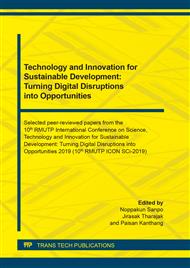[1]
N.K. Niazi, B. Murtaza, I. Bibi, M. Shahid, J.C. White, M.F. Nawaz, S. Bashir, M.B. Shakoor, G. Choppala, G. Murtaza, H. Wang. Removal and recovery of metals by biosorbents and biochars derived from biowastes. Environ. Mater.Waste. 2016. 149-177.
DOI: 10.1016/b978-0-12-803837-6.00007-x
Google Scholar
[2]
A.K. James, R.W. Thring, S. Helle, H.S. Ghuman. Ash management review-Applications of biomass bottom ash. Energies. 5(2012) 3856-3873.
DOI: 10.3390/en5103856
Google Scholar
[3]
J.A. Saria. Levels of heavy metals in bottom ash from medical waste incinerators in Dar es Salaam. J. Multidiscip. Eng. Sci. Stud. 2(2016) 599-605.
Google Scholar
[4]
M. Singh, R. Siddique. Effect of coal bottom ash as partial replacement of sand on properties of concrete. Resour. Conserv. Recy. 72(2013) 20-32.
DOI: 10.1016/j.resconrec.2012.12.006
Google Scholar
[5]
S.N. Sadon, S. Beddu, S. Naganathan, N.L.M. Kamal, H. Hassan. Coal bottom ash as sustainable material in concrete – A review. Indian J. Sci. Technol. 10(2017) 1-10.
Google Scholar
[6]
C. Argiz, M.A. Sanjuán, E. Menéndez. Coal bottom ash for Portland cement production. Adv. Mater. Sci. Eng. (2017).
DOI: 10.1155/2017/6068286
Google Scholar
[7]
C. Argiz A. Moragues, E. Menéndez. Use of ground coal bottom ash as cement constituent in concretes exposed to chloride environments. J. Clean. Prod. (2018) 25-33.
DOI: 10.1016/j.jclepro.2017.09.117
Google Scholar
[8]
F. Becquart, F. Bernard, N.E. Abriak, R. Zentar. Monotonic aspects of the mechanical behaviour of bottom ash from municipal solid waste incineration and its potential use for road construction. Waste Manage. 29(2009) 1320-1329.
DOI: 10.1016/j.wasman.2008.08.019
Google Scholar
[9]
C.L. Lin, M.C. Weng, C.H. Chang. Effect of incinerator bottom ash composition on the mechanical behaviour of backfill material. J. Environ. Manage. 113 (2012) 377-382.
DOI: 10.1016/j.jenvman.2012.09.013
Google Scholar
[10]
C.J. Lynn, G.S. Ghataora, R.K. Dhir. Municipal incinerated bottom ash (MIBA) characteristics and potential for use in road pavements. Int. J. Pavement Res. Technol. 10 (2017) 185-201.
DOI: 10.1016/j.ijprt.2016.12.003
Google Scholar
[11]
J.B. Gorme, M.C. Maniquiz, S.S. Kim, Y.G. Son, Y.T. Kim, L.H. Kim. Characterization of bottom ash as an adsorbent of lead from aqueous solutions. Environ. Eng. Res. 15(2010) 207-213.
DOI: 10.4491/eer.2010.15.4.207
Google Scholar
[12]
T. Benzaoui, A. Selatnia, D. Djabali. Adsorption of copper (II) ions from aqueous solution using bottom ash of expired drugs incineration. Adsorpt. Sci. Technol. 36(2018) 114-129.
DOI: 10.1177/0263617416685099
Google Scholar
[13]
J. Mittal, D. Jhare, H. Vardhan, A. Mittal. Utilization of bottom ash as a low-cost sorbent for the removal and recovery of a toxic halogen containing dye eosin yellow. Desalin. Water Treat. 52(2014) 4508-4519.
DOI: 10.1080/19443994.2013.803265
Google Scholar
[14]
P. Racho, R. Jindal. Heavy metals in bottom ash from a medical-waste incinerator in Thailand. Pract. Period. Hazard. Toxic Radioact. Waste Manage. 8(2004) 31-38.
DOI: 10.1061/(asce)1090-025x(2004)8:1(31)
Google Scholar
[15]
S. Patra, S.T. Whaung, W.L. Kwan. Analysis of heavy metals in incineration bottom ash in Singapore and potential impact of pre-sorting on ash quality. Energy Procedia. 143(2017) 454-459.
DOI: 10.1016/j.egypro.2017.12.710
Google Scholar
[16]
J. Seniunaite, S. Vasarevicius. Leaching of copper, lead and zinc from municipal solid waste incineration bottom ash. Energy Procedia. 113(2017) 442-449.
DOI: 10.1016/j.egypro.2017.04.036
Google Scholar
[17]
Y. Zheng, H.T. Hu, J.Y. Qi. Comparison of digestion methods for analysis of heavy metals in MSWI bottom ash. Key Eng. Mater. 474-476(2011) 1075-1080.
DOI: 10.4028/www.scientific.net/kem.474-476.1075
Google Scholar
[18]
C.H.K. Lam, A.W.M. Ip, J.P. Barford, G. McKay. Use of incineration MSW ash: A review. Sustainability. 2(2010) 1943-1968.
DOI: 10.3390/su2071943
Google Scholar
[19]
H.M. Alhassan, A.M. Tanko. Characterization of solid waste incinerator bottom ash and the potential for its use. Int. J. Eng. Res. Appl. 2(2012) 516-522.
Google Scholar
[20]
A. Saydut. Microwave acid digestion for the determination of metals in subbituminous coal bottom ash by ICP-OES. Energ. Explor. Exploit. 28(2010) 105-115.
DOI: 10.1260/0144-5987.28.2.105
Google Scholar


